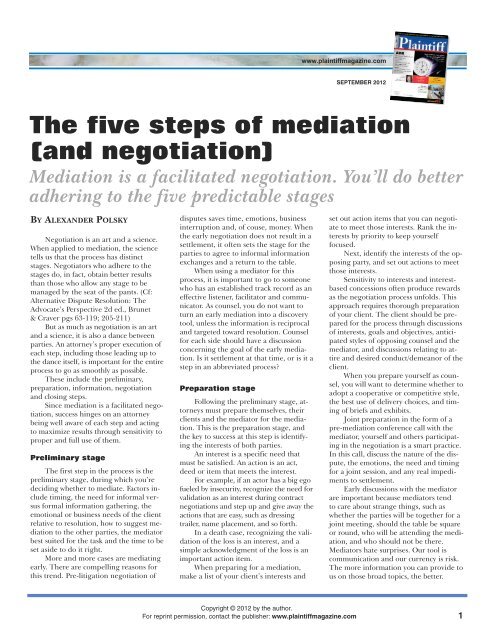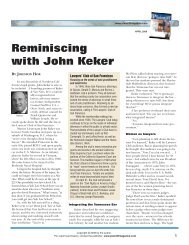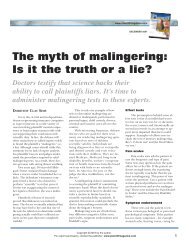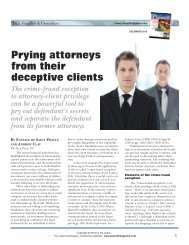The five steps of mediation (and negotiation) - Plaintiff
The five steps of mediation (and negotiation) - Plaintiff
The five steps of mediation (and negotiation) - Plaintiff
Create successful ePaper yourself
Turn your PDF publications into a flip-book with our unique Google optimized e-Paper software.
www.plaintiffmagazine.comSEPTEMBER 2012<strong>The</strong> <strong>five</strong> <strong>steps</strong> <strong>of</strong> <strong>mediation</strong>(<strong>and</strong> <strong>negotiation</strong>)Mediation is a facilitated <strong>negotiation</strong>. You’ll do betteradhering to the <strong>five</strong> predictable stagesBY ALEXANDER POLSKYNegotiation is an art <strong>and</strong> a science.When applied to <strong>mediation</strong>, the sciencetells us that the process has distinctstages. Negotiators who adhere to thestages do, in fact, obtain better resultsthan those who allow any stage to bemanaged by the seat <strong>of</strong> the pants. (Cf:Alternative Dispute Resolution: <strong>The</strong>Advocate’s Perspective 2d ed., Brunet& Craver pgs 63-119; 205-211)But as much as <strong>negotiation</strong> is an art<strong>and</strong> a science, it is also a dance betweenparties. An attorney’s proper execution <strong>of</strong>each step, including those leading up tothe dance itself, is important for the entireprocess to go as smoothly as possible.<strong>The</strong>se include the preliminary,preparation, information, <strong>negotiation</strong><strong>and</strong> closing <strong>steps</strong>.Since <strong>mediation</strong> is a facilitated <strong>negotiation</strong>,success hinges on an attorneybeing well aware <strong>of</strong> each step <strong>and</strong> actingto maximize results through sensitivity toproper <strong>and</strong> full use <strong>of</strong> them.Preliminary stage<strong>The</strong> first step in the process is thepreliminary stage, during which you’redeciding whether to mediate. Factors includetiming, the need for informal versusformal information gathering, theemotional or business needs <strong>of</strong> the clientrelative to resolution, how to suggest <strong>mediation</strong>to the other parties, the mediatorbest suited for the task <strong>and</strong> the time to beset aside to do it right.More <strong>and</strong> more cases are mediatingearly. <strong>The</strong>re are compelling reasons forthis trend. Pre-litigation <strong>negotiation</strong> <strong>of</strong>disputes saves time, emotions, businessinterruption <strong>and</strong>, <strong>of</strong> couse, money. Whenthe early <strong>negotiation</strong> does not result in asettlement, it <strong>of</strong>ten sets the stage for theparties to agree to informal informationexchanges <strong>and</strong> a return to the table.When using a mediator for thisprocess, it is important to go to someonewho has an established track record as aneffective listener, facilitator <strong>and</strong> communicator.As counsel, you do not want toturn an early <strong>mediation</strong> into a discoverytool, unless the information is reciprocal<strong>and</strong> targeted toward resolution. Counselfor each side should have a discussionconcerning the goal <strong>of</strong> the early <strong>mediation</strong>.Is it settlement at that time, or is it astep in an abbreviated process?Preparation stageFollowing the preliminary stage, attorneysmust prepare themselves, theirclients <strong>and</strong> the mediator for the <strong>mediation</strong>.This is the preparation stage, <strong>and</strong>the key to success at this step is identifyingthe interests <strong>of</strong> both parties.An interest is a specific need thatmust be satisfied. An action is an act,deed or item that meets the interest.For example, if an actor has a big eg<strong>of</strong>ueled by insecurity, recognize the need forvalidation as an interest during contract<strong>negotiation</strong>s <strong>and</strong> step up <strong>and</strong> give away theactions that are easy, such as dressingtrailer, name placement, <strong>and</strong> so forth.In a death case, recognizing the validation<strong>of</strong> the loss is an interest, <strong>and</strong> asimple acknowledgment <strong>of</strong> the loss is animportant action item.When preparing for a <strong>mediation</strong>,make a list <strong>of</strong> your client’s interests <strong>and</strong>set out action items that you can negotiateto meet those interests. Rank the interestsby priority to keep yourselffocused.Next, identify the interests <strong>of</strong> the opposingparty, <strong>and</strong> set out actions to meetthose interests.Sensitivity to interests <strong>and</strong> interestbasedconcessions <strong>of</strong>ten produce rewardsas the <strong>negotiation</strong> process unfolds. Thisapproach requires thorough preparation<strong>of</strong> your client. <strong>The</strong> client should be preparedfor the process through discussions<strong>of</strong> interests, goals <strong>and</strong> objectives, anticipatedstyles <strong>of</strong> opposing counsel <strong>and</strong> themediator, <strong>and</strong> discussions relating to attire<strong>and</strong> desired conduct/demeanor <strong>of</strong> theclient.When you prepare yourself as counsel,you will want to determine whether toadopt a cooperative or competitive style,the best use <strong>of</strong> delivery choices, <strong>and</strong> timing<strong>of</strong> briefs <strong>and</strong> exhibits.Joint preparation in the form <strong>of</strong> apre-<strong>mediation</strong> conference call with themediator, yourself <strong>and</strong> others participatingin the <strong>negotiation</strong> is a smart practice.In this call, discuss the nature <strong>of</strong> the dispute,the emotions, the need <strong>and</strong> timingfor a joint session, <strong>and</strong> any real impedimentsto settlement.Early discussions with the mediatorare important because mediators tendto care about strange things, such aswhether the parties will be together for ajoint meeting, should the table be squareor round, who will be attending the <strong>mediation</strong>,<strong>and</strong> who should not be there.Mediators hate surprises. Our tool iscommunication <strong>and</strong> our currency is risk.<strong>The</strong> more information you can provide tous on those broad topics, the better.Copyright © 2012 by the author.For reprint permission, contact the publisher: www.plaintiffmagazine.com 1
www.plaintiffmagazine.comSEPTEMBER 2012When preparing the mediator,please, please do so early. Pick up thephone, send an e-mail, <strong>and</strong> supply a briefat least prior to the weekend before the<strong>mediation</strong>. Your brief should be informative<strong>and</strong> address your risks, as well asthose on the other side. Share real <strong>and</strong>achievable goals <strong>and</strong> objectives with themediator. Remember, the brief is a toolused to enhance the potential for settlement.Information stageWith the first two stages completed,the information stage represents theinitial contact with the other side at the<strong>negotiation</strong>. This might be a joint session,or it might even be as simple as a quickhello in the hallway. Here, the introductionsare made <strong>and</strong> the actual dance betweenthe parties is about to begin.If you have a long relationship withcounsel, either one or many, do not highlightthis fact or become too informal. Ittends to cause concern on the part <strong>of</strong> theother parties at the table.When in any caucus or meeting, theuse <strong>of</strong> open-ended questions might leadto ratification <strong>of</strong> the interest-based decisionsmade at earlier stages <strong>of</strong> theprocess. <strong>The</strong> tone is set during thesemoments. Consider your words <strong>and</strong> actionscarefully. Do you want to set a cooperativetone, or a tension-filledcompetitive tone, right at the start? Yourinitial actions or your reactions to thosefrom the other side will cement a directionthat could be difficult to change.On the other h<strong>and</strong>, be pr<strong>of</strong>essional,<strong>and</strong> ensure that the client does so as well.Demonstrate commitment to the client,case <strong>and</strong> <strong>mediation</strong>. Prepare exhibits;even simple exhibits demonstrate commitment.If the case is fact- <strong>and</strong> time-intensive,use a timeline, which is veryeffective, instead <strong>of</strong> a ten-page writtenoverview.Negotiation stage<strong>The</strong> dance with the other side <strong>of</strong>ficiallybegins with the <strong>negotiation</strong> stage,even though you might have beenpreparing for this moment well in advance.<strong>The</strong>re are three basic approachesto <strong>negotiation</strong>s.<strong>The</strong> competitive bargainer is <strong>of</strong>tenreferred to as a “hard” bargainer or a“positional” bargainer. This negotiatorwants to “win” <strong>and</strong> <strong>of</strong>ten at all costs. Winningis defined in a unilateral sense <strong>and</strong>may <strong>of</strong>ten come without full regard tothe costs. Arguing over “positions” endangersrelationships, increases costs inlitigation <strong>and</strong> <strong>of</strong>ten produces inferiorresults.<strong>The</strong> cooperative negotiator, sometimesthought <strong>of</strong> as “s<strong>of</strong>t,” wants to getalong with everyone <strong>and</strong> produce an easyoutcome in what is <strong>of</strong>ten a difficult situation.This technique <strong>of</strong>ten succeeds, butfrequently leaves the cooperative negotiatorasking the question, “What did I leaveon the table?”<strong>The</strong>n there is interest-based <strong>negotiation</strong>.<strong>The</strong> Harvard Negotiation Projectdeserves credit for coining this concept.In actuality, smart negotiators have beendoing it throughout history. This processfocuses on basic interests, mutually satisfyingoptions <strong>and</strong> fair st<strong>and</strong>ards whereverpossible.In this process there are four keypoints: (1) separate the people from theproblem (2) focus on interests <strong>and</strong> notpositions (3) create a variety <strong>of</strong> possibilitiesbefore <strong>negotiation</strong> or deciding whatto do (4) focus on objective st<strong>and</strong>ards.A close cousin <strong>of</strong> interest-based bargainingis the concept <strong>of</strong> what I call riskbasedfacilitative <strong>negotiation</strong>. © Thistechnique, which I merged into my <strong>mediation</strong>practice 15 years ago, focuses bothon interests <strong>and</strong> on risks. <strong>The</strong> risks, howeverare the risks secondary to the failureto achieve a negotiated outcome.<strong>The</strong> topic <strong>of</strong> every <strong>negotiation</strong> is different.<strong>The</strong> personalities vary while the issues<strong>and</strong> interests are as numerous <strong>and</strong>distinct as grains <strong>of</strong> s<strong>and</strong> in an hourglass.However, combining the principles <strong>of</strong> interest-based<strong>negotiation</strong> with the concept<strong>of</strong> risk is an effective tool to move theparties across the finish line <strong>of</strong> settlement.<strong>The</strong> negotiator wants to WIN. That’sright – WIN. <strong>The</strong> lawyer-negotiator is<strong>of</strong>ten trained to focus on WIN in the context<strong>of</strong> money. That is a monetized outcome.<strong>The</strong> lowest price for the project,the highest dollar value settlement – thelist goes on.Sometimes, the lawyer-negotiator ina business dispute will WIN from a monetizedpoint <strong>of</strong> view but LOSE for theclient in the form <strong>of</strong> excessive attorneyfees, substantial costs, outsized risks <strong>and</strong>in certain situations, negative publicity orthe loss <strong>of</strong> a lucrative, ongoing businessrelationship. <strong>The</strong> idea <strong>of</strong> winning-at-allcosts<strong>of</strong>ten produces a net loss. Riskbasedfacilitation permits the potentialfor mutual gains by balancing each side’spotential WIN with risk or cost associatedwith the failure to achieve a negotiatedoutcome.<strong>The</strong> risk-based approach analyzesthe adverse verdict potential (AVP): Whathappens if the trier agrees with 100 percent<strong>of</strong> what the other side argues? Itthen considers the compromise verdictpotential (CVP): Assume the trier <strong>of</strong> factaccepts some aspects <strong>of</strong> each side’s case.It then considers the costs by consideringthe costs <strong>of</strong> litigation, plus the costs in regardto interests <strong>of</strong> the parties. Win orlose, the interests are charted to analyzethe various ways they are impacted bylitigation.This process yields a present settlementvalue (PSV): <strong>The</strong> risk <strong>of</strong> losing,measured by the potential <strong>of</strong> compromise,<strong>and</strong> balanced with consideration <strong>of</strong>the costs/interests <strong>of</strong> both sides, is thegoal <strong>of</strong> risk-based facilitative <strong>negotiation</strong>.<strong>The</strong> negotiator’s style might be distributive(<strong>of</strong>fer followed by counter <strong>of</strong>fer,etc.) or facilitative (mediator talks privately<strong>and</strong> facilitates movement <strong>of</strong> issues,terms <strong>and</strong> numbers until agreement isreached.)<strong>The</strong> back-<strong>and</strong>-forth <strong>of</strong> distributive <strong>negotiation</strong>is hard on the parties. Emotionalexperiences tend to feel as impersonal asnegotiating for a commodity.In a facilitative <strong>negotiation</strong>, the mediatordoes not deliver <strong>of</strong>fers as much asCopyright © 2012 by the author.For reprint permission, contact the publisher: www.plaintiffmagazine.com 2
www.plaintiffmagazine.comSEPTEMBER 2012concepts, wrapping into the discussion aninterest-based analysis through the use <strong>of</strong>open-ended questions. In this way, theparties themselves can come to their conclusionsin an objective manner. It’s notwho is right or wrong, it’s what the jurysays, <strong>and</strong> how the process impacts one’slife or business. This is well used in emotionalcases. It is driven by issues, <strong>and</strong> canbe much easier <strong>and</strong> s<strong>of</strong>ter on theparties.Closing stage<strong>The</strong> deal is done, the dance has almostcome to an end. Everyone is tired.Time to go home, right? WRONG! Notuntil the closing stage is complete <strong>and</strong>the essential terms <strong>of</strong> the deal are reducedto a writing <strong>and</strong> signed by allparties or, if all parties are not present,all participants. This reduces confusionat best <strong>and</strong> might lead to an enforceableagreement depending on the rules <strong>of</strong> thejurisdiction. Even if not strictly enforceable,it is best to put pen to paper <strong>and</strong>draft a memor<strong>and</strong>um <strong>of</strong> underst<strong>and</strong>ing.<strong>The</strong> takeawayCreate an interest chart for eachside. Identify actions that can be matchedto the interests. Examine the reason behindpositions being asserted, in terms <strong>of</strong>the interests identified. Ask “what <strong>and</strong>how” questions to validate your assumptions.Invent <strong>and</strong> consider all possible optionsfor all sides <strong>and</strong> look for mutualgain. Consider mutual loss if a negotiatedoutcome is not produced.Doing so will help you best leveragethe <strong>five</strong> <strong>steps</strong> <strong>of</strong> <strong>negotiation</strong> to you <strong>and</strong>your client’s advantage, helping to ensurethat your dance with the other side is assuccessful as possible.Alex<strong>and</strong>er S. Polsky is amediator <strong>and</strong> arbitrator withJAMS <strong>and</strong> an adjunct pr<strong>of</strong>essor<strong>of</strong> law at USC. Heh<strong>and</strong>les complex commercial,class action, employment,maritime <strong>and</strong> catastrophicPolsky injury cases at all JAMSCalifornia <strong>of</strong>fices <strong>and</strong>nationwide. He may be reached throughJAMSADR.COM/POLSKY orAlexpolsky@polsky<strong>mediation</strong>.com.Copyright © 2012 by the author.For reprint permission, contact the publisher: www.plaintiffmagazine.com 3












